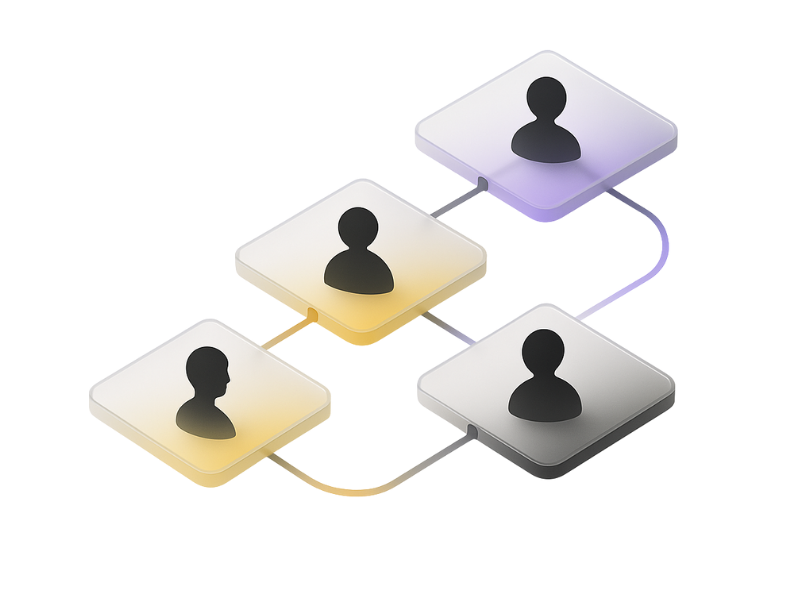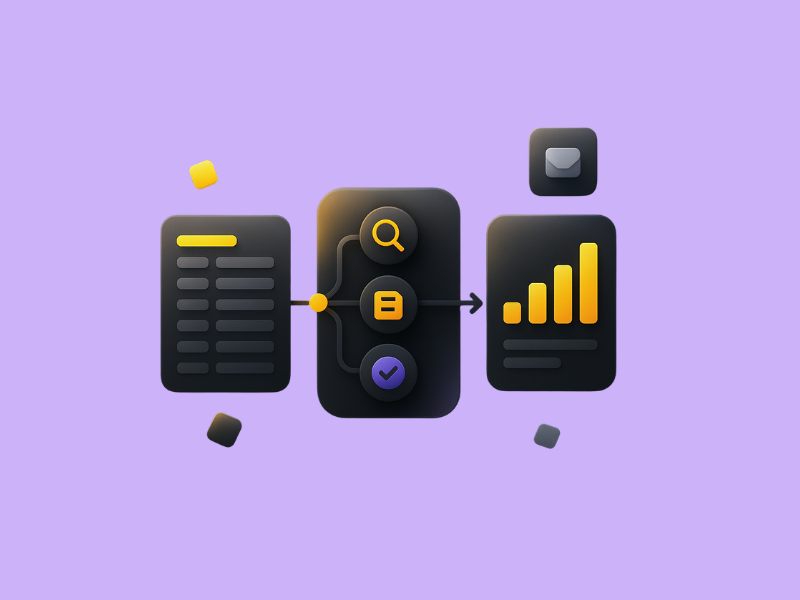Every SDR knows the moment: you open a prospect’s profile, find one useful detail, and the rest of the email writes itself. The gap is doing that for hundreds or thousands of prospects without burning the team to ash. Personalization at scale is less about clever templates and more about turning a single verified signal into repeatable research-driven messages.
TL;DR — If your goal is measurable pipeline growth, treat personalization as structured research. Build small, specialist AI agents for Research, Draft, and QA, power them with enrichment, and follow a prompt → few-shot → fine-tune path. Run a 100-contact pilot, instrument leading indicators (signals found, QA pass rate, time to approval), and only scale on data. See the agent templates library and the studio walkthrough for ready-made chains.
Why this matters now
Outbound volumes and buyer fatigue are both rising. Generic templates hit fewer inboxes and win fewer replies. Recent benchmarks show that personalized subject lines can lift opens meaningfully, and industry open-rate benchmarks vary widely by vertical. HubSpot reports personalized subject lines are often over 20% more likely to be opened, and up-to-date open-rate reports help set realistic targets. HubSpot’s email benchmarks are a useful baseline when you design A/B tests.
Make this urgent: run experiments on small, instrumented batches (10–100 rows). You learn fast. If you scale from day one without those signals, you compound errors and risk deliverability and reputation.
Our point of view
Personalization at scale only works when you separate responsibilities: research, creation, and brand/compliance checks. That separation reduces hallucinations, makes failures visible, and creates assets you can re-use. Our POV: multi-agent model chaining plus progressive model customization yields predictable lift and operational safety.
Trade-offs matter. Prompt engineering moves fast and is cheap; few-shot examples buy consistency; fine-tuning or distillation buys repeatable voice but costs time and money. Follow a staged path so you don’t pay for scale until you can measure lift in controlled tests. OpenAI’s docs show how fine-tuning and distillation are powerful but billed processes — treat them as owned investments after you validate gains with prompts and few-shot examples. OpenAI and its model-distillation notes are handy references for costs and when to invest.
How we think about outcomes: prioritize reply and qualified-meeting lift first, then pipeline contribution. Measure both leading indicators (signals per contact, QA fail rate, time to send) and lagging outcomes (reply rate, qualified meetings, pipeline value).
Framework: three layers that make research repeatable
At the highest level, run Outreach as a program with three layers:
- Layer 1 — Enrichment & Signals: canonical inputs (LinkedIn headline, recent blog post, latest press, first-party behavior). These are the facts your drafts must cite.
- Layer 2 — Multi-agent chain: Research agent → Draft agent(s) → QA agent → Reply classifier. Each agent has a single responsibility and a pass/fail decision rule.
- Layer 3 — Measurement & Ops: instrument the chain with traceability (agent ID, source URLs, confidence scores) and run small controlled A/Bs before scaling.
One simple diagram to picture: Research (scrape & enrich) → Draft (3 variants) → QA (tone & facts) → Send. If QA fails, route to human review. If reply arrives, classify and branch. This swimlane keeps ownership clear and makes audits straightforward.
Quick checklist for production readiness:
- At least three reliable enrichment sources per account (example: LinkedIn headline, company blog, recent press).
- Research agent must return a confidence score and source URL for each signal.
- QA agent must enforce: 1) at least one cited signal in message body, 2) approved voice profile compliance, 3) no prohibited claims.
- Instrumentation that records agent ID and the source URL in CRM activity for every sent message.
How to apply this: build the chain, run it on 10 rows to validate inputs, then 100 for a short pilot.
Seven AI strategies to implement now
Below are practical strategies, each with a workflow, an instrumentation tip, and a short decision rule you can use in a pilot.
1) Signal‑first subject lines
Workflow: let the Research agent extract one strong datapoint (recent funding, a specific product launch, or a title change). The Subject agent writes a 6–8 word subject referencing that datapoint. Instrumentation: store the source URL and a boolean “signal found” tag on the message record. Decision rule: only auto-send when one verified signal exists.
How to apply this: for a 100-contact pilot, require at least one signal per contact or send a fallback template via a human queue.
2) Mini research snippet in sentence one
Workflow: the Draft agent slots a one-line context snippet into the first sentence (e.g., “Saw your piece on X last week — loved the point on Y”). Add the source link and a confidence score in the CRM note. Decision rule: auto-send only when confidence > 0.6; otherwise, route to SDR for manual touch.
How to apply this: capture the snippet and its URL in the activity timeline so reviewers can verify quickly.
3) Behavioral variable stitching
Workflow: combine first-party signals (trial started, visited pricing, webinar attendee) with public signals. Use tokens beyond name and title—try variables like “recent page visited” and “trial start date.” Instrumentation: record recency and event id. Decision rule: include behavioral tokens only when the event is under 14 days old.
How to apply this: keep a personalization budget per contact—deep personalization for high-value targets, shallow for lower value.
4) Multi-step chaining for sequences
Workflow: produce distinct intents per step. Day 1 = research-first outreach. Day 3 = tailored value add (link to short asset + why it matters to their role). Day 7 = meeting ask with a clear CTA. Each message is produced by the appropriate draft agent and checked by QA. Decision rule: stop the sequence when negative signals appear (unsubscribe, explicit no interest, or sustained negative classification).
How to apply this: map the cadence in your CRM and tag each step with the agent and the source URLs it relied on.
5) Reply-aware branching
Workflow: use a reply-classifier agent to parse inbound replies into intents (question, scheduling request, not interested, ask to call later). Feed that classification back into the chain and generate the next-step message or routing instruction. Instrumentation: SLA to route classified “question” replies to the assigned SDR within one hour. Decision rule: if classification confidence < 0.7, route to human.
How to apply this: test the classifier on historic replies and measure precision before relying on it live.
6) Adaptive personalization depth
Workflow: choose between shallow, medium, or deep personalization based on account value and intent signals; deep personalization is reserved for high‑value accounts. Instrumentation: personalization budget field per contact (or per seq). Decision rule: deep personalization only for accounts above your ABV threshold or where intent score exceeds the set threshold.
How to apply this: capture personalization time vs lift; if deep personalization costs more than the expected incremental pipeline, prefer medium-personalize + better cadence.
7) Asset compounding via training sets
Workflow: capture accepted drafts and QA corrections as labeled training examples. Use those to create few‑shot prompts, then move to fine‑tuning or distilled models once you have enough high-quality examples. OpenAI’s guidance and distillation offerings show how to transition to lower-cost models after you have a stable dataset. Model distillation and fine-tuning docs are useful references when budgeting this step.
Decision rule: consider fine-tuning or distillation when you have hundreds of clean examples and A/B tests show consistent lift; otherwise keep iterating on prompts and few-shot examples.
How to apply these together: pick two strategies that complement each other (for example, Signal‑first subject lines + Reply‑aware branching) and run them on 100 contacts to see interaction effects.
Applications and a 1‑week pilot SDR playbook
Teams that win with this are explicit about who owns each step. For an SDR leader or RevOps owner running a one‑week pilot on 100 contacts, here’s a practical playbook:
- Day 0 — Prepare: 100 contacts CSV, LinkedIn URLs, last 90-day behavior events. Assign roles: ops owner, SDR owner, reviewer.
- Day 1 — Build agents: Research, Draft, QA, Reply classifier inside your studio. Hook enrichment connectors. Add the agent IDs to the CRM mapping. (See enrichment connectors.)
- Day 2 — Run on 10 contacts: validate source capture, QA fail rates, and time to approval.
- Day 3 — Adjust prompts and QA rules, expand to 100 contacts and run a randomized control split: 50 control (current template) vs 50 treatment.
- Day 7+ — Measure leading indicators (signals/contact, QA pass rate) and lagging outcomes at 30 days (reply rate, qualified meetings). Use a pre-defined acceptance criteria: at least 3pp absolute lift or 30% relative lift in reply rate vs control.
Roles and acceptance criteria should be explicit. Use traceability for every message: agent ID, source URL, and QA pass flag. If you want a checklist you can apply immediately, download the pilot checklist.
Brand bridge — How Personize helps
Outcome: reliable, measurable personalization that increases reply and meeting rates. How: a no-code multi-agent studio that chains Research → Draft → QA and writes back to HubSpot with source links and agent IDs. See how this agent works in Personize Studio.
Objections and common pitfalls
Objection: “AI will create inconsistent voice and risk brand tone.” Rebuttal: separate creator and QA agents. Let only QA‑approved messages auto-send and log corrections as training data. That keeps voice consistent and gives you labeled examples to improve few‑shot prompts.
Objection: “This will break deliverability when we scale.” Rebuttal: instrument deliverability as a first-class metric. Start small, monitor domain reputation, use adaptive throttling, and vary send windows by account tier. Also ensure templates and research-based drafts follow best practices for link domains and text-to-image ratios.
Objection: “Fine‑tuning is costly and slow.” Rebuttal: do not fine‑tune prematurely. Follow prompt → few‑shot → fine‑tune. OpenAI’s fine-tuning and distillation docs outline price and process — use them to plan when to invest. OpenAI’s billing guide is a useful reference for planning costs.
FAQ
- Q: How many signals per contact do I need to personalize effectively?
- A: Start with one high-quality signal (a recent blog, funding, or a behavioral touch). For deep personalization, aim for 2–3 corroborating signals. Always capture the source URL and confidence score so you can audit the claim.
- Q: When should I move from prompts to fine‑tuning?
- A: Our rule-of-thumb: stick with prompts and few-shot until you have at least several hundred high‑quality accepted drafts and controlled A/B evidence of consistent lift; then evaluate fine‑tuning or distillation for repeatability and cost-savings.
- Q: How do I protect deliverability while testing?
- A: Use low-volume throttling, monitor sender scores and open rates, vary send times, and route QA‑flagged items to human review instead of auto-sending. Track domain reputation as a KPI in the pilot.
Sources
- HubSpot — Subject line stats & personalization findings
- HubSpot — Email open-rate benchmarks
- HubSpot — Why mass email is dead and personalization works
- OpenAI — Fine-tuning guidance and cost considerations
- OpenAI — Model distillation for cost-efficient production models
- OpenAI — Billing guide for fine-tuning / RFT








